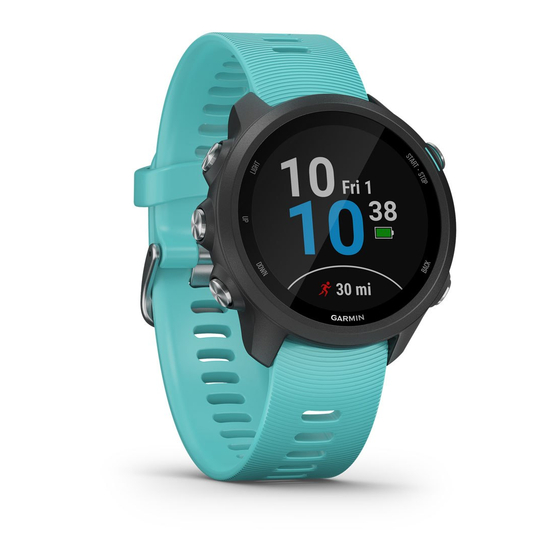Garmin FORERUNNER 245 Manual del usuario - Página 33
Navegue en línea o descargue pdf Manual del usuario para Ver Garmin FORERUNNER 245. Garmin FORERUNNER 245 40 páginas.

• On your device, hold LIGHT, and select
Bluetooth technology and enter pairing mode.
Maximizing Battery Life
You can do several things to extend the life of the battery.
• Reduce the backlight timeout
Settings, page
25).
• Turn off Bluetooth wireless technology when you are not
using connected features
page
9).
• When pausing your activity for a longer period of time, use
the Resume Later option
• Turn off activity tracking
• Use a watch face that is not updated every second.
For example, use a watch face without a second hand
(Customizing the Watch Face, page
• Limit the smartphone notifications the device displays
(Managing Notifications, page
• Stop broadcasting heart rate data to paired Garmin devices
(Broadcasting Heart Rate Data to Garmin Devices, page
• Turn off wrist-based heart rate monitoring
Wrist-based Heart Rate Monitor, page
NOTE: Wrist-based heart rate monitoring is used to calculate
vigorous intensity minutes and calories burned.
• Turn off the pulse oximeter feature
based Heart Rate Monitor, page
• Use UltraTrac GPS mode for your activity
page
24).
• Select the Smart recording interval
page
24).
The temperature reading is not accurate
Your body temperature affects the temperature reading for the
internal temperature sensor. To get the most accurate
temperature reading, you should remove the watch from your
wrist and wait 20 to 30 minutes.
You can also use an optional tempe external temperature
sensor to view accurate ambient temperature readings while
wearing the watch.
How can I manually pair ANT+ sensors?
You can use the device settings to manually pair ANT+ sensors.
The first time you connect a sensor to your device using ANT+
wireless technology, you must pair the device and sensor. After
they are paired, the device connects to the sensor automatically
when you start an activity and the sensor is active and within
range.
1
Stay 10 m (33 ft.) away from other ANT+ sensors while
pairing.
2
If you are pairing a heart rate monitor, put on the heart rate
monitor.
The heart rate monitor does not send or receive data until
you put it on.
3
Hold UP.
4
Select Settings > Sensors & Accessories > Add New.
5
Select an option:
• Select Search All.
• Select your sensor type.
After the sensor is paired with your device, a message
appears. Sensor data appears in the data page loop or a
custom data field.
Appendix
to turn on
(Changing the Backlight
(Bluetooth Connected Features,
(Stopping an Activity, page
(Activity Tracking Settings, page
24).
1).
(Turning Off the
12).
(Turning Off the Wrist-
12).
(UltraTrac,
(System Settings,
Can I use my Bluetooth sensor with my
watch?
The device is compatible with some Bluetooth sensors. The first
time you connect a sensor to your Garmin device, you must pair
the device and sensor. After they are paired, the device
connects to the sensor automatically when you start an activity
and the sensor is active and within range.
1
Hold UP.
2
Select Settings > Sensors & Accessories > Add New.
3
Select an option:
• Select Search All.
3).
• Select your sensor type.
8).
You can customize the optional data fields
Data Screens, page
My music cuts out or my headphones do not
stay connected
When using a Forerunner 245 Music device connected to
headphones using Bluetooth technology, the signal is strongest
11).
when there is a direct line of sight between the device and the
antenna on the headphones.
• If the signal passes through your body, you may experience
signal loss or your headphones may become disconnected.
• It is recommended to wear your headphones with the
antenna on the same side of your body as your
Forerunner 245 Music device.
Data Fields
Some data fields require ANT+ accessories to display data.
% Heart Rate Reserve: The percentage of heart rate reserve
(maximum heart rate minus resting heart rate).
24-Hour Maximum: The maximum temperature recorded in the
last 24 hours.
24-Hour Minimum: The minimum temperature recorded in the
last 24 hours.
Aerobic Training Effect: The impact of the current activity on
your aerobic fitness level.
Anaerobic Training Effect: The impact of the current activity on
your anaerobic fitness level.
Average % Heart Rate Reserve: The average percentage of
heart rate reserve (maximum heart rate minus resting heart
rate) for the current activity.
Average Cadence: Running. The average cadence for the
current activity.
Average Cadence: Cycling. The average cadence for the
current activity.
Average GCT Balance: The average ground contact time
balance for the current session.
Average Ground Contact Time: The average amount of
ground contact time for the current activity.
Average Heart Rate: The average heart rate for the current
activity.
Average Heart Rate %Max.: The average percentage of
maximum heart rate for the current activity.
Average Lap Time: The average lap time for the current
activity.
Average Pace: The average pace for the current activity.
Average Speed: The average speed for the current activity.
Average Stride Length: The average stride length for the
current session.
(Customizing the
22).
Appendix
29
